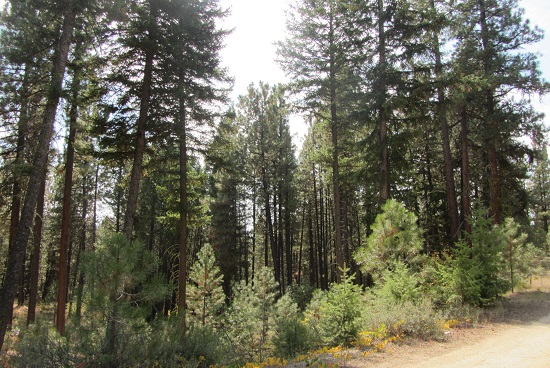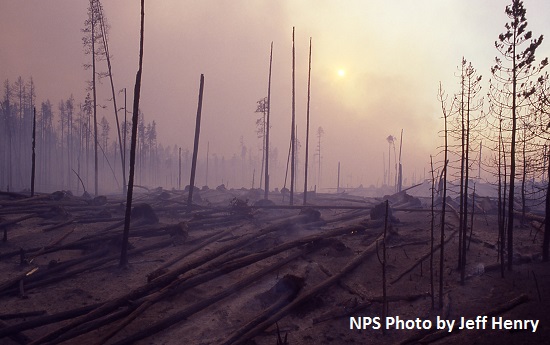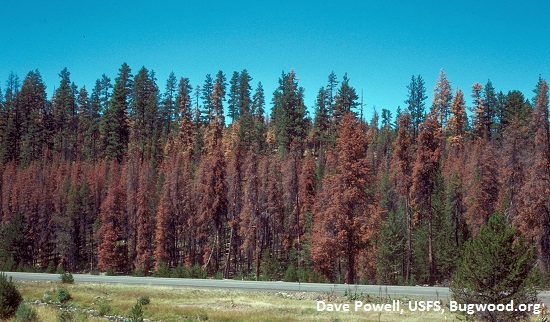In the Northern Rockies region, climate change, its effects on and interactions with ecosystem disturbances as well as its challenges for land management is an active area of research. The NRFSN has highlighted this critical management issue by presenting and briefly summarizing some of the valuable resources available on climate change and disturbance topics important to fire and land management.
Climate change and vegetation response
Climate change and fire projections
Climate change and disturbance interactions
Management options for complexity and uncertainty
 Climate change and vegetation response - Climate change in the western U.S. will mean warmer temperatures and altered precipitation regimes. Projected changes in precipitation are less certain than projections for increased temperatures, which have already occurred and are predicted to continue to warm. Predictions about precipitation changes in the northwestern U.S. include variable increases and decreases in annual moisture and increased intensity of variability in precipitation events. It is important to remember, however, that temperature regulates many hydrologic processes important to forest growth and survival, such as snowmelt, summer evapotranspiration, and seasonal soil moisture changes. Warmer temperatures in the cold season will increase the snowline elevation and increase the frequency of rain on snow events.
Climate change and vegetation response - Climate change in the western U.S. will mean warmer temperatures and altered precipitation regimes. Projected changes in precipitation are less certain than projections for increased temperatures, which have already occurred and are predicted to continue to warm. Predictions about precipitation changes in the northwestern U.S. include variable increases and decreases in annual moisture and increased intensity of variability in precipitation events. It is important to remember, however, that temperature regulates many hydrologic processes important to forest growth and survival, such as snowmelt, summer evapotranspiration, and seasonal soil moisture changes. Warmer temperatures in the cold season will increase the snowline elevation and increase the frequency of rain on snow events.
With expected temperature increases and its effects on hydrologic processes, many potential forest vegetation changes could occur. Depending on the species, its position within its range, and local temperature changes, increased or decreased growth, stress, and competition, shifts in range, and conversion of cover types are all possible. At high elevations, forest growth and biomass production could be increased by climate change, whereas at low elevation sites, increased incidents or extended periods of drought may reduce forest growth and limit regeneration. To plan for these potential changes, regions have developed climate change vulnerability assessments. For the Northern Rockies, the assessments, which include descriptions of the species' current condition, existing stressors, sensitivity to and expected effects of climate changes, and adaptive capacity, nearly all tree species evaluated had a moderate to high exposure to and risk of climate change impacts.
- Preliminary resource vulnerability assessment - Northern Region Adaptation Partners 2014
- Climate change impacts on forest and non-forest vegetation and disturbance interactions - Keane, Reeves, & Loehman 2014 (webinar - Forested systems: 11:00-35:30, Nonforested systems: 36:30-57:00)
- The impacts of climate change on ecosystem structure and function - Grimm & others 2013
- Forest responses to climate change in the northwestern United States: ecophysiological foundations for adaptive management - Chmura & others 2011
- Climate change resource center website - USFS
 Climate change and fire projections - Increases in fire frequency and size associated with a warming climate have already been documented over the last several decades in the western U.S.; predictions suggest this trend will continue. Earlier snowmelt and longer summers have coincided with the increased occurrence of fires and area burned, and the Northern Rockies region has accounted for the largest burned area increases in the West. Projections are that very large wildfires (50,000 acres or more) will increase in the western U.S. over the long term. Areas with relatively cool, wet climates, like the Northern Rockies, will experience greater future likelihood of very large wildfires than areas with warmer, drier climates where drought conditions may limit fuels.
Climate change and fire projections - Increases in fire frequency and size associated with a warming climate have already been documented over the last several decades in the western U.S.; predictions suggest this trend will continue. Earlier snowmelt and longer summers have coincided with the increased occurrence of fires and area burned, and the Northern Rockies region has accounted for the largest burned area increases in the West. Projections are that very large wildfires (50,000 acres or more) will increase in the western U.S. over the long term. Areas with relatively cool, wet climates, like the Northern Rockies, will experience greater future likelihood of very large wildfires than areas with warmer, drier climates where drought conditions may limit fuels.
Climate change effects on fire will likely overshadow the impacts of climate change on vegetation alone, and changes to fire regimes have greater potential than climate change alone to result in species distributions or cover type conversions. A fire-return interval that becomes shorter than the time required for a tree species to reproduce could foster a change in species dominance or vegetation type. A fire regime that becomes more severe than historical could result in increased fire mortality and vegetation shifts to dominance by more fire-adapted species. Modeling simulations have revealed climate tipping points where some climate change scenarios changed landscapes and fire regimes significantly and persistently from current conditions. Simulations for the East Fork Bitterroot River Basin, for example, showed surface fires becoming a mix of surface and crown fires when temperature increases exceeded 5.4 degrees and precipitation did not increase. The warmest and driest climate scenarios resulted in changes from forest- to shrub- and grass-dominated landscapes.
- Climate change and the eco-hydrology of fire: will area burned increase in a warming western USA? - McKenzie & Littell 2016
- Fire and drought (Chapter 7) - Littell & others 2016
- Human-caused climate change is now a key driver of forest fire activity in the western United States - Harvey 2016
- Climate change presents increased potential for very large fires in the contiguous United States - Barbero & others 2015
- Projected major fire and vegetation changes in the Pacific Northwest of the conterminous United States under selected CMIP5 climate futures - Sheehan & others 2015
- Regional projections of the likelihood of very large wildland fires under a changing climate in the contiguous western United States - Stavros & others 2014
- Briefing: climate and wildfire in western U.S. forests - Westerling & others 2014
- The impacts of changing disturbance regimes on serotinous plant populations - Buma & others 2013
- Estimating critical climate-driven thresholds in landscape dynamics using spatial simulation modeling: climate change tipping points in fire management - Keane & Loehman 2013
- Response of western mountain ecosystems to climatic variability and change: a synthesis from the Western Mountain Initiative - Raymond 2013
- Climate change and forest disturbances - Dale & others 2001
- Climate change resource center website - USFS
 Climate change and disturbance interactions - An added level of uncertainty beyond the potential changes in local weather patterns, vegetation responses, and fire regimes comes from predicting future disturbance interactions. While disturbance interactions are natural and common landscape processes (e.g. fires following bark beetle outbreaks, debris flows after fire, blowdown event followed by fire, drought conditions followed by insect or pest outbreaks), they have the potential to produce unexpected disturbance behaviors and vegetation responses through nonlinear, cascading, or cumulative effects. Research in a southern Rockies subalpine forest found that interacting disturbances, a blowdown in 1997 and a fire in 2002, nearly eliminated serotinous lodgepole pine, which typically dominates post-fire regeneration when present at the time of burning. The transfer of serotinous seed from the canopy to the ground, where fire temperatures and burn duration were highest was likely the reason for poor serotinous lodgepole pine regeneration.
Climate change and disturbance interactions - An added level of uncertainty beyond the potential changes in local weather patterns, vegetation responses, and fire regimes comes from predicting future disturbance interactions. While disturbance interactions are natural and common landscape processes (e.g. fires following bark beetle outbreaks, debris flows after fire, blowdown event followed by fire, drought conditions followed by insect or pest outbreaks), they have the potential to produce unexpected disturbance behaviors and vegetation responses through nonlinear, cascading, or cumulative effects. Research in a southern Rockies subalpine forest found that interacting disturbances, a blowdown in 1997 and a fire in 2002, nearly eliminated serotinous lodgepole pine, which typically dominates post-fire regeneration when present at the time of burning. The transfer of serotinous seed from the canopy to the ground, where fire temperatures and burn duration were highest was likely the reason for poor serotinous lodgepole pine regeneration.
If climate change results in larger, more frequent, and/or more severe disturbances, the chance of multiple interacting disturbances may increase across space and time. Understanding how climate change may impact the likelihood, trajectory, and outcomes of these interactions is important yet the complexity and potential number and scale of disturbance interaction changes makes understanding and preparing for them overwhelming. However ecosystem resilience is predictable even in the face of shifting disturbance regimes, climate, and land-use change through knowledge and appreciation of life-history traits, disturbance characteristics, climate sensitivity, and successional dynamics.
For a broader discussion about fire and bark beetles, visit our Fire and Bark Beetles webpage.
- Changing disturbance regimes, ecological memory, and forest resilience - Johnstone & others 2016
- Disturbance interactions: characterization, prediction, and the potential for cascading effects - Buma 2015
- Temperate forest health in an era of emerging megadisturbance - Millar & Stephenson 2015
- Climate change impacts on forest and non-forest vegetation and disturbance interactions - Keane, Reeves, & Loehman 2014 (webinar - Disturbance interactions: 1:03:00-1:32:00)
- Fires and beetles and climate, oh my! - Turner 2014 (video keynote presentation, 60 min)
- The impacts of changing disturbance regimes on serotinous plant populations - Buma & others 2013
- Consequences of spatial heterogeneity for ecosystem services in changing forest landscapes: priorities for future research - Turner & others 2013
- Climate change, forests, fire, water, and fish: building resilient landscapes, streams, and managers - Luce & others 2012
- Climate change and bark beetles of the western United States and Canada: direct and indirect effects - Bentz & others 2010
- Climate change resource center website - USFS

Management options for complexity and uncertainty - With the complexity and uncertainty surrounding climate change effects on ecosystems and disturbances, land management challenges will likely increase. However, a number of guidelines and strategies have been developed to inform management. The guidelines and strategies include short-term and long-term planning and are designed to be used in combination to promote ecosystem resistance and resilience or assist in ecosystem adaptation.
While management actions will be necessarily site- and situation-specific, several broad concepts and strategies are useful to understand and implement for any more specific planning or management (from Millar & others 2014):
- Education and training - integrate climate change basics and principles with local knowledge
- Science-management partnerships - collaborate for reciprocal learning and development of goals and plans that address feasibility
- Risk and uncertainty - identify risks, assess vulnerabilities, develop actions that are realistic while minimizing risks
- No-regrets decision making - implement actions with little to no risk of undesirable actions freely
- Adaptive learning - let adaptation strategies be flexible, use experimentation
- Mixed-models approach - dissipate model uncertainty by utilizing a variety of different types of models with different inputs and assumptions
More specific guidelines for developing a forest adaptation plan, include (from Peterson & others 2011):
- Review - bring knowledge to the planning and analysis process, review the literature to determine whether or how climate change will affect the project
- Rank - develop priorities based on their potential benefits and risks as well as capacity and likelihood of success, recognize lost causes
- Resolve - develop goals, objectives, and propose actions, which promote resistance to change, resilience to change, assistance to change, or realignment of highly disturbed ecosystems. Resistance to change actions are appropriate for high-value resources and only have only short term success. Resilience to change actions work to reduce the stress on species or systems. Actions that assist change are proactive strategies that work with the changes being provoked to assist transitions while minimizing or mitigating disruptions. Actions to realign ecosystems are most common in watershed restoration.
- Observe - monitor responses and modify goals, objectives, and methods accordingly, learn from outcomes and use this knowledge in future planning
Additional and more fire-specific strategies, include (from Stevens & others 2013, Turner & others 2012, Joyce & others 2009, Millar & others 2007):
- Wildland-urban interface - improve planning and development in the WUI, discourage building in hazardous areas, be strategic with fuel treatment placement
- Heterogeneity - retain unburned patches, legacy trees, and key seed sources for regeneration, maintain connectivity of habitat
- Biological diversity - experiment with species and genotypes, utilize seed zone transfer guidelines, identify ways to conserve fire-sensitive species, populations, and communities
- Watersheds - improve the resilience of watershed processes and services through protection, maintenance, or restoration
- Post-fire - monitor post-fire conditions, control nonnative species early
- Restoration - avoid trying to replicate historical conditions, but take lessons from historical variation
- Stakeholders - make stakeholders aware of climate change, work with local stakeholders early and often
- Surprises - expect mega droughts, larger fires, species extirpations, loss of resilience and system collapses, and incorporate the what-ifs into planning
Applying resilience thinking (video) - Stockholm University 2015
Managing for climate change on federal lands of the western United States: perceived usefulness of climate science, effectiveness of adaptation strategies, and barriers to implementation - Kemp & others 2015
Adapting to climate change - Millar & others 2014
Applying resilience thinking - Seven principles for building resilience in social-ecological systems - Stockholm University 2014
Managing forests and fire in changing climates - Stephens & others 2013
Consequences of spatial heterogeneity for ecosystem services in changing forest landscapes: priorities for future research - Turner & others 2013
Responding to climate change in national forests: a guidebook for developing adaptation options - Peterson & others 2011
Managing for multiple resources under climate change: National Forests - Joyce & others 2009
Climate change resource center website - USFS